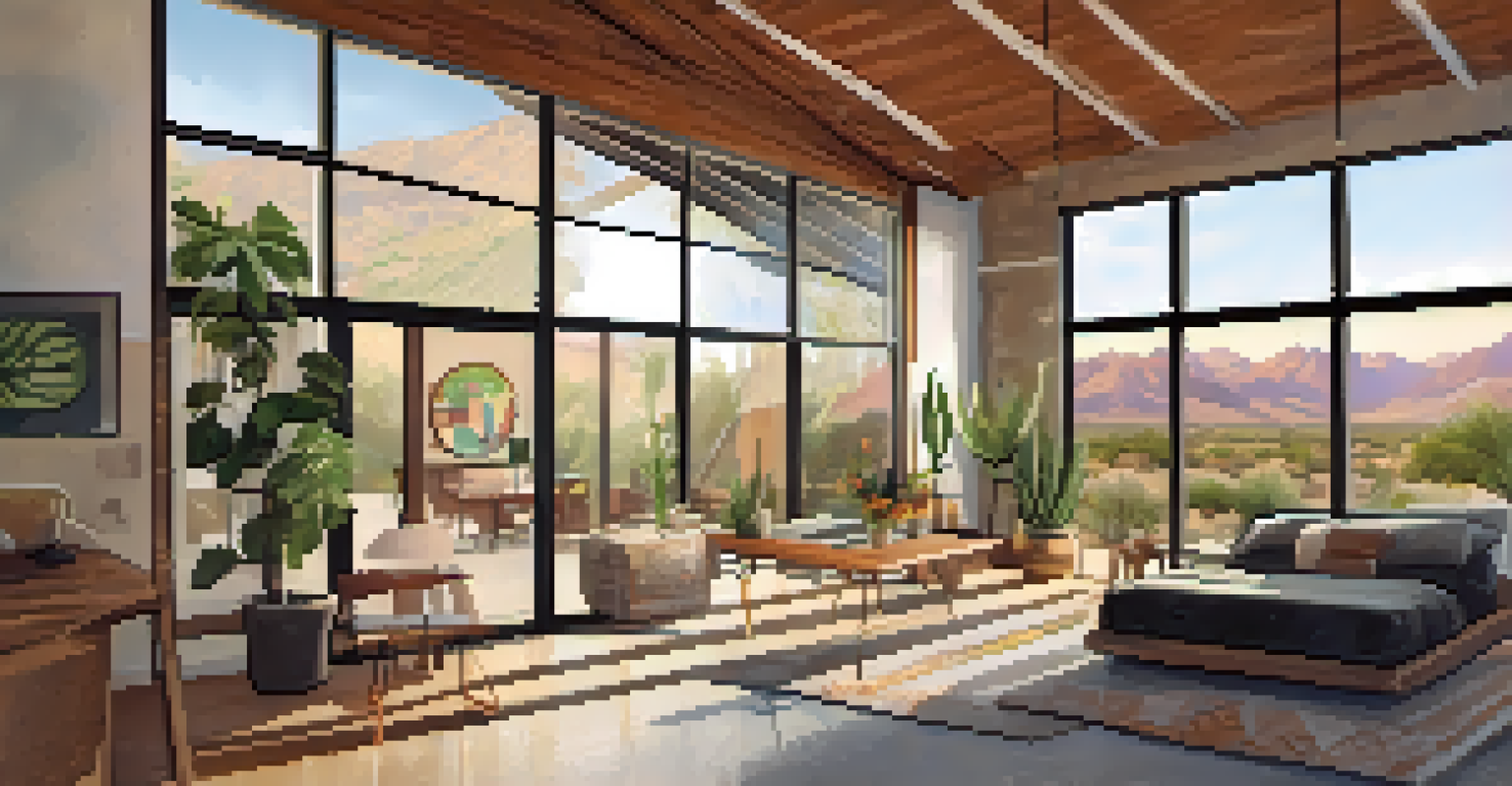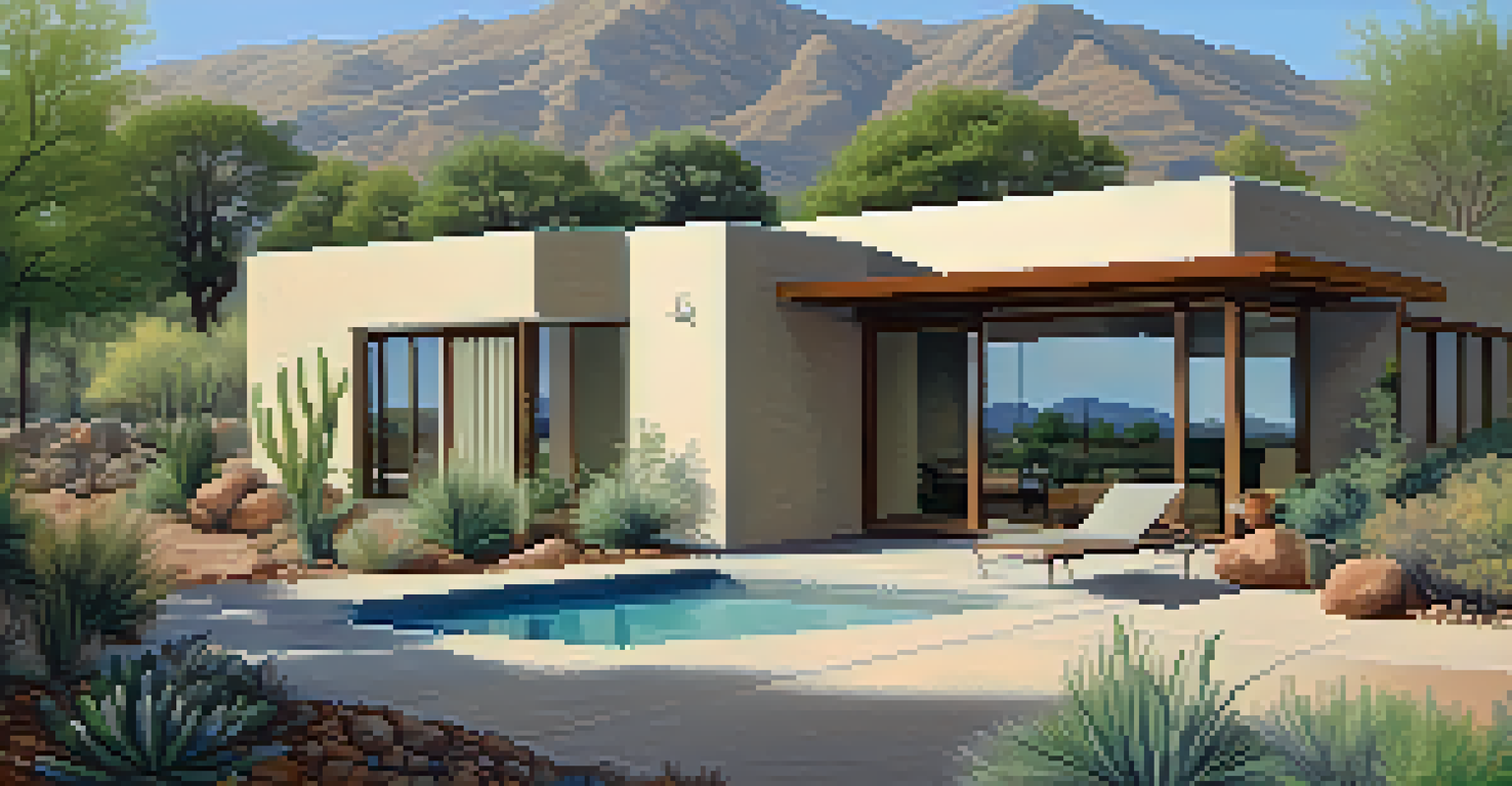Passive Solar Design: Tucson's Approach to Energy Efficiency

Understanding Passive Solar Design and Its Importance
Passive solar design is a method that takes advantage of natural energy sources to heat and cool buildings effectively. By strategically using sunlight and wind, this design minimizes reliance on artificial heating and cooling systems. In places like Tucson, where the sun shines brightly year-round, this approach is particularly valuable.
The sun is the source of all energy, and if we can harness it properly, we can create a sustainable future.
The essence of passive solar design lies in its ability to create comfortable living spaces without excessive energy consumption. This means using architectural features like large windows, thermal mass materials, and strategic shading. Essentially, it’s about harmonizing a building with its environment to maximize energy efficiency.
As the world increasingly focuses on sustainability, passive solar design has emerged as a significant player in reducing carbon footprints. This approach not only benefits homeowners through lower energy bills but also contributes to a healthier planet. In Tucson, embracing this design philosophy is a crucial step toward a more sustainable future.
Tucson's Unique Climate and Its Role in Passive Solar Design
Tucson's arid climate presents both challenges and opportunities for passive solar design. With scorching summers and mild winters, the city provides a perfect backdrop for optimizing solar energy. The key is to capture the sun's warmth during colder months while preventing overheating in the summer.

The use of thermal mass—materials that absorb and store heat—is particularly effective in Tucson's climate. For instance, adobe and concrete can help maintain comfortable indoor temperatures by stabilizing temperature fluctuations. By understanding the local climate, architects can design buildings that naturally regulate heat.
Benefits of Passive Solar Design
Passive solar design enhances comfort and reduces energy costs for Tucson residents.
Additionally, Tucson's location allows for strategic orientation of buildings to maximize sunlight exposure during winter while minimizing it during summer. This thoughtful placement is essential in creating energy-efficient homes that work with the environment rather than against it. By leveraging its unique climatic conditions, Tucson stands out in the realm of passive solar design.
Key Features of Passive Solar Design in Tucson
In Tucson, several key features define successful passive solar designs. Large overhangs and awnings are common, providing shade to windows and walls during the hottest parts of the day. This simple yet effective design element helps keep interiors cool and comfortable.
Sustainability is not a choice anymore; it is a necessity for the survival of our planet.
Another important aspect is the use of thermal mass materials. Homes often incorporate elements like concrete floors or brick walls, which absorb heat during the day and release it slowly at night. This creates a natural temperature regulation system that reduces reliance on mechanical heating and cooling.
Furthermore, strategically placed windows and skylights enhance natural lighting while minimizing heat gain. By using double or triple-glazed windows, homeowners can reduce energy loss and improve insulation. These features combine to create a harmonious living environment that prioritizes energy efficiency.
The Role of Landscaping in Passive Solar Design
Landscaping plays a crucial role in enhancing the effectiveness of passive solar design. In Tucson, strategically planted trees and vegetation can provide essential shade and wind protection. This not only cools outdoor spaces but also reduces the heat that enters homes.
Deciduous trees, which lose their leaves in winter, are particularly beneficial. They can block the intense summer sun while allowing sunlight to warm the home during colder months. This seasonal shading is invaluable in maintaining energy efficiency throughout the year.
Tucson's Climate Advantage
The city's arid climate allows for effective utilization of passive solar design strategies.
Moreover, incorporating native plants in landscaping supports local biodiversity and requires less water, aligning with Tucson's efforts to promote sustainability. Thoughtful landscaping not only enhances the aesthetic appeal of a property but also complements the principles of passive solar design.
Benefits of Passive Solar Design for Tucson Residents
The benefits of passive solar design extend beyond mere energy savings for Tucson residents. Homeowners experience increased comfort levels, thanks to naturally regulated temperatures that eliminate the extremes of heating and cooling. This leads to a more pleasant living environment year-round.
Additionally, lower utility bills are a significant advantage. By utilizing the sun’s energy efficiently, families can save money on their monthly energy costs, allowing them to invest in other aspects of their lives. Over time, these savings can add up, making passive solar design a financially wise choice.
Furthermore, adopting passive solar design contributes to a greater sense of community and environmental stewardship. As more residents embrace sustainable practices, Tucson can become a model for energy efficiency and climate resilience. This collective effort fosters pride in the community and a commitment to a sustainable future.
Challenges in Implementing Passive Solar Design
Despite its many benefits, passive solar design does come with challenges, especially in Tucson. One common hurdle is the initial cost of construction or retrofitting existing homes. While energy savings can be substantial over time, upfront investment can deter some homeowners.
Moreover, not all properties are ideally suited for passive solar design. Factors like lot orientation, existing structures, and local zoning regulations can limit design possibilities. Homeowners must work closely with architects to find creative solutions that fit their specific circumstances.
Challenges in Implementation
Initial construction costs and property limitations can hinder the adoption of passive solar design.
Lastly, educating the community about the advantages and feasibility of passive solar design is crucial. Many residents may not fully understand the concept or its potential benefits. Raising awareness through workshops, community events, and outreach programs can help demystify passive solar design and encourage its adoption.
Future of Passive Solar Design in Tucson
Looking ahead, the future of passive solar design in Tucson seems promising. As technology advances, new materials and methods will enhance the effectiveness of passive solar strategies. Innovations in energy efficiency and sustainable building practices will likely become more mainstream.
Additionally, as climate change continues to impact local weather patterns, the need for energy-efficient homes will only grow. Tucson residents will increasingly recognize the importance of building designs that work with nature rather than against it. This shift could lead to more widespread adoption of passive solar principles.

Finally, community-driven initiatives and government incentives can accelerate the transition to passive solar design. By promoting sustainability and energy efficiency, Tucson can position itself as a leader in environmentally friendly living. The future looks bright for passive solar design in this vibrant desert city.